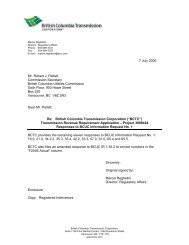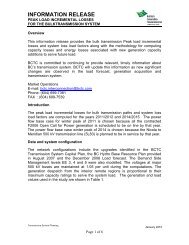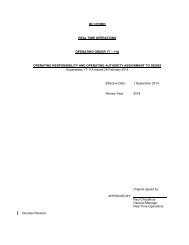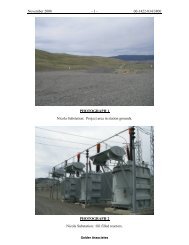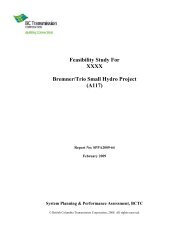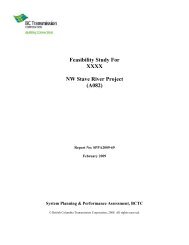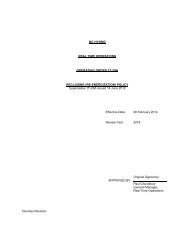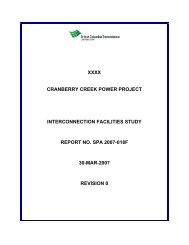Evidence on the Adequacy of First Nations Consultation - BC Hydro ...
Evidence on the Adequacy of First Nations Consultation - BC Hydro ...
Evidence on the Adequacy of First Nations Consultation - BC Hydro ...
Create successful ePaper yourself
Turn your PDF publications into a flip-book with our unique Google optimized e-Paper software.
DRAFT REPORT: Rights and Title Interests in <strong>the</strong> Columbia Valley Transmissi<strong>on</strong> Project Area<br />
5.0 CONCLUSIONS<br />
This report has reviewed and assessed an extensive literature <strong>of</strong> both ethnographic and<br />
ethnohistoric documentati<strong>on</strong> in an effort to examine <strong>the</strong> identity <strong>of</strong> <strong>First</strong> Nati<strong>on</strong>s who may assert<br />
rights and title interests to <strong>the</strong> area <strong>of</strong> <strong>the</strong> Columbia Valley Transmissi<strong>on</strong> Project.<br />
N<strong>on</strong>-aboriginal fur traders first entered <strong>the</strong> Upper Columbia River regi<strong>on</strong> in <strong>the</strong> early 1800s<br />
expecting to find Ktunaxa people. Their journals, corresp<strong>on</strong>dence and maps indicate that <strong>the</strong>y<br />
observed very few aboriginal Aboriginal people in <strong>the</strong> regi<strong>on</strong>, although various parties undertook<br />
several rec<strong>on</strong>naissance trips through <strong>the</strong> area at different times <strong>of</strong> <strong>the</strong> year. In <strong>the</strong> summer <strong>of</strong><br />
1807, David Thomps<strong>on</strong> sent his men looking for <strong>the</strong> Ktunaxa. A few days later a band had been<br />
found and Thomps<strong>on</strong> called up<strong>on</strong> <strong>the</strong>ir assistance to help provide for his party and for <strong>the</strong><br />
company horses. Building his trade depot near Toby Creek, Thomps<strong>on</strong> recognized explicitly that<br />
he was in <strong>the</strong> territory <strong>of</strong> <strong>the</strong> Ktunaxa.<br />
Both <strong>the</strong> historical and ethnographic evidence describe <strong>the</strong> Ktunaxa practice <strong>of</strong> a semi-nomadic<br />
subsistence quest that took <strong>the</strong>m annually to a number <strong>of</strong> locati<strong>on</strong>s within a defined area. The<br />
ethnographic evidence indicates that this area included hunting grounds located as far north as<br />
Golden. It was in <strong>the</strong>se most nor<strong>the</strong>rn hunting grounds where <strong>the</strong> Kinbasket family’s oral<br />
histories report first encountering <strong>the</strong> Ktunaxa when <strong>the</strong>y, <strong>the</strong> Kinbasket, moved south, sometime<br />
after <strong>the</strong>ir initial move to <strong>the</strong> Columbia River. These same traditi<strong>on</strong>s indicate that it had not been<br />
<strong>the</strong> former practice ei<strong>the</strong>r <strong>of</strong> <strong>the</strong> Kinbasket family, or member bands <strong>of</strong> <strong>the</strong> Shuswap Lake<br />
Divisi<strong>on</strong>, to hunt as far south as Golden, although <strong>the</strong>y formerly hunted as far east as <strong>the</strong> Big<br />
Bend and Canoe River areas, where <strong>the</strong>y encountered Secwepemc people bel<strong>on</strong>ging to <strong>the</strong> North<br />
Thomps<strong>on</strong> band. A single historical reference to a people known as <strong>the</strong> “Snare Indians” does not<br />
explicitly place <strong>the</strong>m as far south as <strong>the</strong> Project area. The ethnic affiliati<strong>on</strong> <strong>of</strong> <strong>the</strong> “Snare” people<br />
remains an open debate.<br />
It is possible that <strong>the</strong> Kinbasket family’s encounter with <strong>the</strong> Ktunaxa resulted when <strong>the</strong><br />
Secwepemc moved south (upstream) <strong>on</strong> <strong>the</strong> Columbia and <strong>the</strong> Ktunaxa moved north, both filling<br />
a vacuum left by earlier depopulati<strong>on</strong>. In 1910-1913, ethnographer James Teit put forward this<br />
opini<strong>on</strong> when he reviewed his notes <strong>on</strong> tribal territories. Ktunaxa people he interviewed<br />
acknowledged an earlier occupati<strong>on</strong> <strong>of</strong> <strong>the</strong> area which some believed to have been “in<br />
mythological times,” an occupati<strong>on</strong> that some regarded as ei<strong>the</strong>r n<strong>on</strong>-human or n<strong>on</strong>-Ktunaxa. It<br />
is <strong>the</strong> positi<strong>on</strong> <strong>of</strong> <strong>the</strong> Shuswap Indian band that <strong>the</strong>se people were <strong>the</strong>ir own direct ancestors.<br />
Subsequent ethnographic investigati<strong>on</strong>s reported that <strong>on</strong>e <strong>of</strong> <strong>the</strong> Ktunaxa bands had a<br />
headquarters at Toby Creek, near where David Thomps<strong>on</strong> established Kootanae House in 1807,<br />
but this Ktunaxa band had suffered greatly from <strong>the</strong> smallpox epidemic <strong>of</strong> <strong>the</strong> early 1780s. The<br />
available evidence indicates that <strong>the</strong> Ktunaxa used <strong>the</strong> Columbia Valley for fishing and hunting<br />
at this time and that <strong>the</strong>ir use <strong>of</strong> <strong>the</strong> Columbia Valley c<strong>on</strong>tinued.<br />
The evidence reviewed here suggests that <strong>the</strong> Ktunaxa did not object to <strong>the</strong> Kinbasket band<br />
establishing a settlement am<strong>on</strong>g <strong>the</strong>m. The evidence is clear that at least by 1845, Secwepemc<br />
Bouchard & Kennedy Research C<strong>on</strong>sultants Page 82<br />
Page 85 <strong>of</strong> 200






